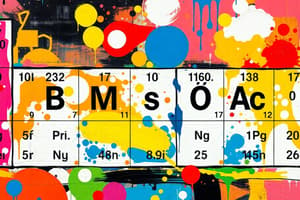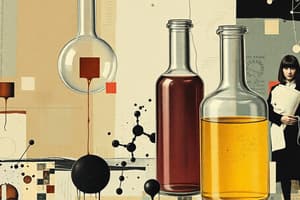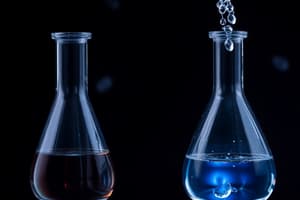Podcast
Questions and Answers
What is the smallest part of an element that can exist?
What is the smallest part of an element that can exist?
Atom
What is a molecule?
What is a molecule?
A molecule is made of a fixed number of atoms, which are covalently bonded together.
Which of the following is NOT a type of atom?
Which of the following is NOT a type of atom?
- Atom
- Neutron
- Electron
- Proton (correct)
What is the name given to tiny particles which make up elements?
What is the name given to tiny particles which make up elements?
What are elements?
What are elements?
What are elements arranged by in the periodic table?
What are elements arranged by in the periodic table?
What is a compound?
What is a compound?
What are the smallest particles with a positive charge?
What are the smallest particles with a positive charge?
What is a nuclear model?
What is a nuclear model?
According to the plum pudding model, what is the atom composed of?
According to the plum pudding model, what is the atom composed of?
The majority of the mass of an element is in the nucleus.
The majority of the mass of an element is in the nucleus.
What is a key difference between Rutherford's nuclear model and Thompson's plum pudding model?
What is a key difference between Rutherford's nuclear model and Thompson's plum pudding model?
What is the atomic number of an element?
What is the atomic number of an element?
What does the relative atomic mass (Ar) represent?
What does the relative atomic mass (Ar) represent?
What is the difference between isotopes of the same element?
What is the difference between isotopes of the same element?
What are the highly reactive metals in groups 1 and 2 of the periodic table known as?
What are the highly reactive metals in groups 1 and 2 of the periodic table known as?
What are the elements in group 0 of the periodic table also known as?
What are the elements in group 0 of the periodic table also known as?
What is the process of separating a solvent from a solution by heating it, collecting the vapor, and then cooling it to form liquid?
What is the process of separating a solvent from a solution by heating it, collecting the vapor, and then cooling it to form liquid?
What is fractional distillation used to separate?
What is fractional distillation used to separate?
Which technique separates a soluble substance from a solvent by forming crystals?
Which technique separates a soluble substance from a solvent by forming crystals?
What is paper chromatography used to separate?
What is paper chromatography used to separate?
What is the process of separating a mixture by passing it through a filter paper?
What is the process of separating a mixture by passing it through a filter paper?
What does a compound involve that makes it different from a mixture?
What does a compound involve that makes it different from a mixture?
Flashcards
What is an atom?
What is an atom?
The smallest unit of an element that can exist.
What is an element?
What is an element?
A substance made up of only one type of atom.
What is a compound?
What is a compound?
A substance made up of two or more elements chemically combined together in a fixed ratio.
What is a chemical equation?
What is a chemical equation?
Signup and view all the flashcards
What are reactants?
What are reactants?
Signup and view all the flashcards
What are products?
What are products?
Signup and view all the flashcards
What does it mean to balance a chemical equation?
What does it mean to balance a chemical equation?
Signup and view all the flashcards
What are state symbols?
What are state symbols?
Signup and view all the flashcards
What is an ion?
What is an ion?
Signup and view all the flashcards
What is a positive ion?
What is a positive ion?
Signup and view all the flashcards
What is a negative ion?
What is a negative ion?
Signup and view all the flashcards
What is atomic number?
What is atomic number?
Signup and view all the flashcards
What is mass number?
What is mass number?
Signup and view all the flashcards
What are isotopes?
What are isotopes?
Signup and view all the flashcards
What is the relative atomic mass (Ar)?
What is the relative atomic mass (Ar)?
Signup and view all the flashcards
What is the electron configuration?
What is the electron configuration?
Signup and view all the flashcards
What is a group in the periodic table?
What is a group in the periodic table?
Signup and view all the flashcards
What is a period in the periodic table?
What is a period in the periodic table?
Signup and view all the flashcards
What are metals?
What are metals?
Signup and view all the flashcards
What are non-metals?
What are non-metals?
Signup and view all the flashcards
What are alkali metals?
What are alkali metals?
Signup and view all the flashcards
What are alkaline earth metals?
What are alkaline earth metals?
Signup and view all the flashcards
What are transition metals?
What are transition metals?
Signup and view all the flashcards
What are noble gases?
What are noble gases?
Signup and view all the flashcards
What is ionization?
What is ionization?
Signup and view all the flashcards
What is thermal conductivity?
What is thermal conductivity?
Signup and view all the flashcards
What is electrical conductivity?
What is electrical conductivity?
Signup and view all the flashcards
What is malleability?
What is malleability?
Signup and view all the flashcards
What is ductility?
What is ductility?
Signup and view all the flashcards
What is metallic character?
What is metallic character?
Signup and view all the flashcards
What is non-metallic character?
What is non-metallic character?
Signup and view all the flashcards
Study Notes
Mixtures and Compounds
- Mixtures are made of two or more elements or compounds mixed together without chemical bonds.
- The chemical properties of each substance in a mixture do not change.
- Mixtures can be separated by physical processes, such as filtration, crystallisation and distillation.
- Mixtures can include solids, liquids, or gases.
Compounds
- Compounds are formed from two or more elements bonded together chemically.
- Compounds have different chemical properties from the elements they are made of.
- Compounds can be separated by chemical reactions.
Separating Mixtures
- Substances in a mixture can be separated by physical processes.
- Filtration can separate an insoluble solid from a liquid.
- Crystallisation is used to separate a dissolved solid from a liquid solvent. Process involves evaporating the solvent and cooling, forming crystals.
- Distillation, can be used to separate a liquid solvent from a solution by heating the mixture and collecting the vapour that condenses.
- Fractional distillation is used to separate liquids from a mixture of miscible liquids, which have different boiling points.
Waste Water Treatment
- Large objects are removed (branches and leaves).
- Insoluble particles are removed (coarse filter bed)
- Smaller insoluble particles are removed (fine filter)
- Harmful microorganisms are removed (chlorine gas).
- Water becomes potable.
Seawater Treatment
- Seawater can be made drinkable by distillation.
- Seawater boils, and the water vapor is cooled, forming pure water.
Distillation
- Distillation is used to separate a solvent from a solution.
- Set up apparatus with round-bottomed flask, heat source, thermometer, condenser, and collecting beaker.
- Heat the solution until the liquid evaporates to vapour.
- Cool the vapor in the condenser to turn it back into a liquid and collect it in a separate beaker.
- The solute remains in the original flask.
- The boiling point of the solute is higher than the solvent.
Fractional Distillation
- Used to separate liquids with different boiling points in a mixture.
- A fractionating column (long tube with glass beads) is used.
- The mixture is heated. The liquid with the lowest boiling point evaporates first and rises through the column.
- The vapours condense at different points on the column, depending on their boiling points.
- The liquids are collected at different points in the column.
Filtration
- Separates an insoluble solid from a liquid.
- Pour the mixture into a filter funnel with filter paper.
- The insoluble solid (residue) is retained on the filter paper.
- The liquid (filtrate) passes through the filter paper.
Crystallisation
- Separates a soluble solid from a solution.
- Heat the solution to evaporate some or all of the solvent, concentrating the solution.
- Slowly cool the solution to allow the dissolved solid to form crystals.
- Crystals are separated by filtration.
Paper Chromatography
- Separates mixtures of soluble substances based on their differing solubility in a solvent.
- A mixture is dissolved in a solvent.
- A small amount of the mixture is placed on a piece of chromatography paper.
- The paper is placed in a suitable solvent.
- The solvent moves up the paper, carrying the different substances at varying speeds, depending on their solubility.
- The separated substances are seen as different colored spots on the paper.
Studying That Suits You
Use AI to generate personalized quizzes and flashcards to suit your learning preferences.





